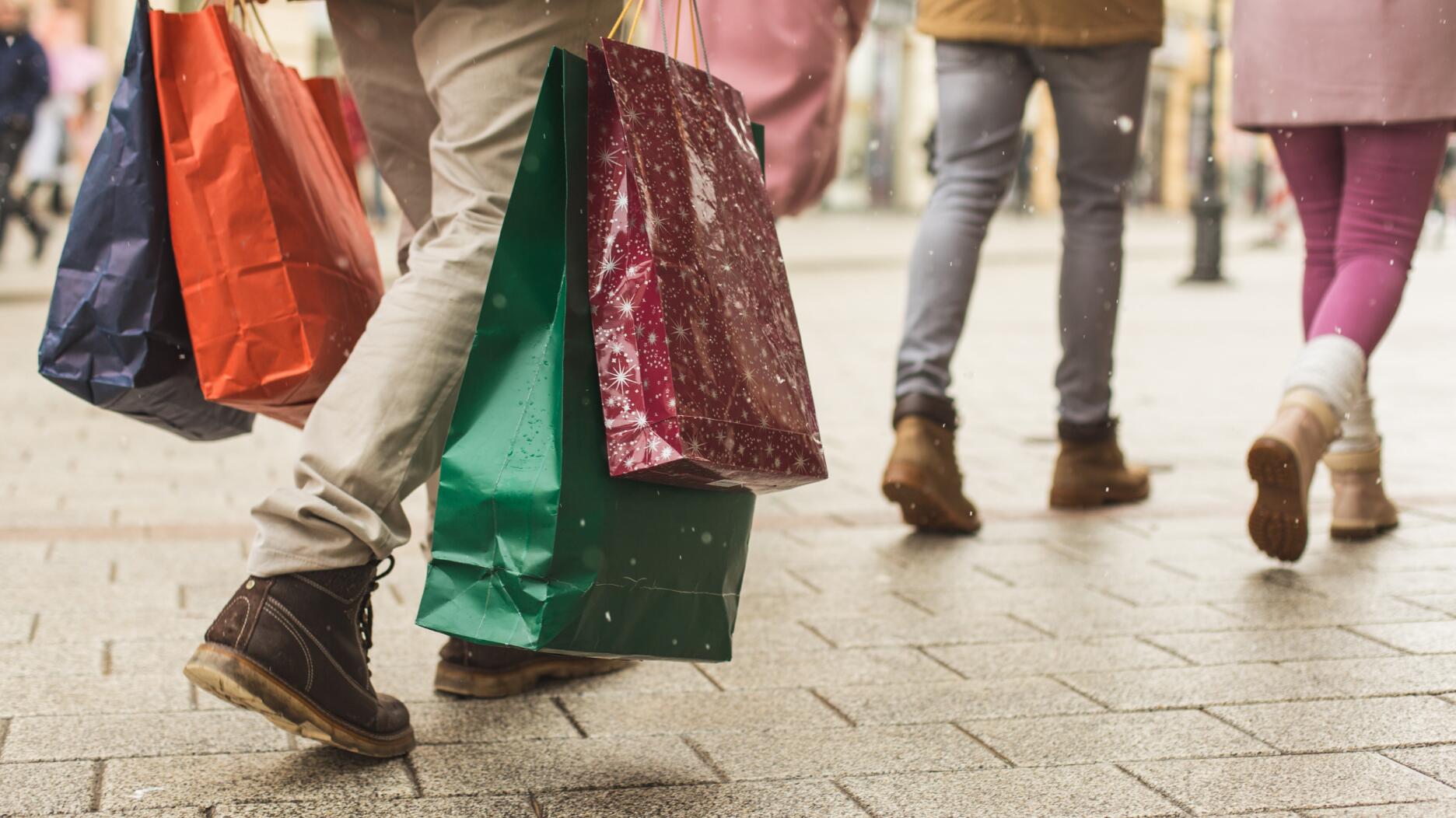10-Year Rewind: Comparing 2024 Holiday Shoppers With the Consumers of 2015
PricewaterhouseCoopers’ 2024 holiday trends survey took a 10-year look back to see what mattered to consumers then versus now.

For its 10th annual “Holiday Outlook” report, PricewaterhouseCoopers (PwC) is glancing in the rearview mirror instead, comparing the priorities of today’s shoppers with the values of shoppers in 2015.
From online versus in-store shopping to cautious spending, here are the top four takeaways from the report.
Consumers this year are more pessimistic than they were in 2015.
While “2015” may not sound like that long ago, a lot has changed in the last decade, from our technological capabilities to our political climate.
In 2015, Instagram was only five years old, and there were no Reels or TikTok.
Barack Obama was in the middle of his second term as president.
“Jurassic World” was the summer box office hit while series fans bid adieu to “Glee,” “Parks and Recreation,” and “Mad Men.” Notably, these shows aired on network TV while many of today’s top shows are available via streaming services.
The pandemic that would bring the world to standstill was five years away.
In 2015, 85 percent of consumers told PwC they plan to spend the same or more on holiday gifts than they did in 2014.
This year, only 66 percent of consumers plan to spend the same or more than last year, while 26 percent plan to spend more.
Meanwhile, the percentage of shoppers planning to spend less (29 percent) has nearly doubled when compared with 2015.
“This shift signals a more cautious market, requiring businesses to refine their value propositions and adapt strategies to capture diverse consumer segments,” said PwC.
Notably, millennials are the biggest spenders, both in 2015 and now.
Millennials, defined by PwC as ages 28-43, continue to drive overall spending, the report said, with their average holiday spend up 22 percent year-over-year to $2,222.
Millennials are also more likely to buy and receive experience-type gifts, and plan to allocate 20 percent of their overall holiday budget to entertainment.
Gen Z, defined as ages 17-27, is catching up, with holiday spending among this age group up 37 percent year-over-year to $1,752.
Members of Gen Z also are more likely to buy gifts for themselves, with 37 percent of their budget allocated to personal purchases. For all consumers, it’s 32 percent.
“While Gen Z leads in budget increases across the board, Gen X (defined as ages 44-59) plans to scale back this holiday, especially on gifts and travel,” said the report.
Gen X and the baby boomers, defined as ages 60-78, plan to reduce their budgets by 9 percent and 6 percent year-over-year, respectively.
Shoppers overall plan to spend an average of $1,638 on gifts, travel, and entertainment this holiday season, said PwC, a 7 percent increase from 2023.
PwC attributed the increase in part to the impact of inflation. There has also been an emphasis on experiences and travel, with consumers valuing these options even more after being restricted during the height of the COVID-19 pandemic.
In 2015, consumers planned to spend $1,018 on holiday gifts, travel, and entertainment.
Though this year’s average may suggest higher overall spending, individual behaviors can vary.
“While some consumers are spending more and others are cutting back, the numbers reflect both varied spending habits and the influence of inflation, which has driven up costs across the board,” said the report.
The study noted some regional differences in projected spending, with the South experiencing the largest jump year-over-year at 29 percent, followed by the West (15 percent), the Midwest (12 percent), and the Northeast (0.4 percent).
As shoppers prioritize price, retailers may want to focus on marketing and promotions.
Offering promotions may seem obvious for the holiday season, but it’s a particularly good strategy for attracting shoppers this year, according to PwC.
In 2015, 70 percent of holiday shoppers said price was the primary driver of their spending choices. This year, 89 percent cited price as being paramount.
“This year’s diverse spending patterns reflect broader economic trends and changing consumer priorities. They also signal a holiday season of evolving purchasing behaviors that should shape how retailers approach pricing and promotion in the coming year,” said the report.
Shoppers will likely take a mixed approach to holiday shopping, looking for deals while spending more on select gifts.
The report suggested retailers focus on upping consumer marketing and offering strategically timed promotions.
In-store shopping is less popular now than it was in 2015.
In 2015, nearly 60 percent of consumers planned to do their holiday shopping in a physical store.
This year, it’s 45 percent as shoppers turn to a “mixed-mode” approach, said PwC, shopping both in stores and online.
Despite the decline in the last decade, PwC said physical stores still play an important role in holiday shopping, due in part to their experiential appeal.
Nearly one-fifth of those surveyed (22 percent) said holiday displays and store atmosphere got them to head to a store, followed by holiday-specific products (21 percent), and making an event out of holiday shopping (17 percent).
“Physical storefronts are still important … By blending innovative, experience-driven offerings with trusted, tactile shopping environments, they can effectively cater to both emerging and established consumer bases.” — PwC 2024 “Holiday Outlook” report
Notably, customers who shop in stores more often spend more, averaging $2,307 compared with $1,297 for those who do more of their shopping online.
The report also noted a preference for tech-enhanced shopping experiences, with 63 percent of frequent in-store shoppers saying self-checkout technology and mobile payment solutions are important.
“Physical storefronts are still important. To run them effectively, retailers should clearly define how these stores serve their target customers,” said PwC.
“By blending innovative, experience-driven offerings with trusted, tactile shopping environments, they can effectively cater to both emerging and established consumer bases.”
Holiday spending may hit a plateau this year.
In its report, PwC outlined how consumer behavior has changed during the last 10 years.
From 2015 to 2019, the percentage of shoppers planning to spend more increased steadily each year due to a “robust” economy, rising disposable income, and increases in consumer confidence, PwC said.
“[The year] 2020 marked a significant departure from the previous trend. The COVID-19 pandemic led to widespread uncertainty, economic disruptions, and a dramatic shift in consumer priorities,” said PwC.
For the first time in a decade, the percentage of customers planning to spend more for the holidays sank, with the focus going to essential spending due to economic uncertainty and health concerns.
From 2021 to 2023, holiday spending began to rebound, with online shopping continuing to grow while in-store shopping began its slow recovery, leading to a hybrid model by 2023.
This year, consumers are taking a more cautious approach to the holiday season.
“Despite economic growth, the percentage of consumers planning to spend more has hit its lowest point since 2020, reflecting a shift toward saving and financial security,” said PwC.
“However, fewer consumers plan to cut spending, indicating a stabilization. Many are taking a cautious ‘wait-and-see’ approach, balancing financial prudence with holiday traditions.”
To read the full report, visit the PwC website.
The Latest

The luxury goods company said founder Ippolita Rostagno will remain at the brand’s helm.

Laura Burdese, who joined the Italian luxury brand in 2022, will take on the role in July.

The National Jeweler editors revisit the most noteworthy industry happenings and design trends from 2025.

How Jewelers of America’s 20 Under 40 are leading to ensure a brighter future for the jewelry industry.

Need a gift for the cat lover who has everything? Look no further than our latest Piece of the Week.


It purchased the “Grosse Pièce,” an ultra-complicated Audemars Piguet pocket watch from the ‘20s, for a record-breaking price at Sotheby’s.

The lab-grown diamond grower now offers custom engagement and fashion jewelry through its Kira Custom Lab Jewelry service.

Roseco’s 704-page catalog showcases new lab-grown diamonds, findings, tools & more—available in print or interactive digital editions.

Chandler got his start at Michelson Jewelers and has served as DCA president and CEO since 2001. He will retire at the end of the month.

The boutique is slated to open this week inside Terminal 8, offering pre-owned Rolex watches and more to international travelers.

Sponsored by Digital Monitoring Products

The special-edition egg pendant ingested in a New Zealand jewelry store was recovered after a six-day wait.

Associate Editor Natalie Francisco plays favorites with Piece of the Week, selecting a standout piece of jewelry from each month of 2025.

The “Love and Desire” campaign is inspired by the magic that follows when one’s heart leads the way, said the brand.

Two awardees will receive free tuition for an educational course at the Swiss lab, with flights and lodging included.

Berta de Pablos-Barbier will replace Alexander Lacik at the start of January, two months earlier than expected.

Sotheby’s held its first two jewelry sales at the Breuer building last week, and they totaled nearly $44 million.

Winners will receive free registration and lodging for its fourth annual event in Detroit.

Here are six ideas for making more engaging content for Instagram Reels and TikTok, courtesy of Duvall O’Steen and Jen Cullen Williams.

The honorees include a notable jewelry brand, an industry veteran, and an independent retailer.

Carlos Jose Hernandez and Joshua Zuazo were sentenced to life without the possibility of parole in the 2024 murder of Hussein “Sam” Murray.

Yood will serve alongside Eduard Stefanescu, the sustainability manager for C.Hafner, a precious metals refiner in Germany.

The New Orleans jeweler is also hosting pop-up jewelry boutiques in New York City and Dallas.

Set in a Tiffany & Co. necklace, it sold for $4.2 million, the highest price and price per carat paid for a Paraíba tourmaline at auction.

The jeweler’s “Deep Freeze” display showcases its iconic jewelry designs frozen in a vintage icebox.

Take luxury gifting to new heights this holiday season with the jeweler’s showstopping 12-carat sphene ring.

This year's theme is “Unveiling the Depths of the Ocean.”



























